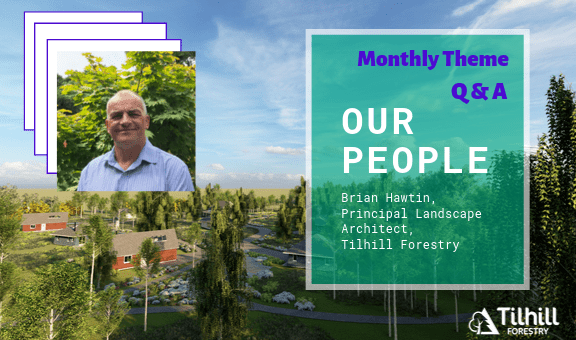This month’s theme is ‘Our People’ celebrating Tilhill Forestry’s staff and their fantastic work.
We asked Brian Hawtin, Principal Landscape Architect all about his job role and working for Tilhill Forestry
What do you do? Tell us about your typical day?
There is no typical day for me. I divide my time between Landscape Architecture (both design and landscape and visual impact assessments), contracting landscape works, tendering for upcoming works and opening doors to new business.
How did you get into landscaping?
Back in the mists of time I started working for a friend who was a gardener thinking it would do until something else came along. The month I started was the wettest month we’d had for twenty years but I stayed and I haven’t found anything better since. We started doing landscaping in addition to gardening and then I moved onto design and contracting.
What do you like most about working in the landscaping industry?
Leaving your impression on the land. I suppose that applies to many in the industry, but I look at the landscapes of Capability Brown and his contemporaries and marvel that they could see in their minds eye what we see now. Today the thrust of what I want to do is more about the light touch, preserving and enhancing what we have rather than creating something wholly new, but green space is quickly being recognised as hugely beneficial to health and wellbeing and this aspect fascinates me.
Why did you decide to work for Tilhill Forestry?
A great opportunity to help build something special. There is so much potential within our client base and the areas in which we work which is not necessarily open to other landscape companies and that means we have huge potential.
What do you like most about Tilhill Forestry?
The people… I work in a great office with a fantastic atmosphere.
How do you feel Tilhill Forestry contributes to its employees’ professional development?
Any training or professional development that I have asked for has been supported and welcomed as well as a full programme of training including first aid and site management. This has included personal development as well as common training delivered across the district.
What sorts of changes are occurring in your occupation?
The big move currently is climate change, urban forests and carbon offsetting. The unique perspective Tilhill can offer is that Forestry and Landscape Architecture have a number of crossover points that are not immediately visible unless you have those cross-discipline conversations. We have those conversations in the office and it informs our landscape design work, as well as the other way round.
How does landscaping link into forestry?
There are aspects of crossover that go way beyond the design of forest roads and tracks. We have looked at achieving access to sites for development through a conservation woodland using a multi-disciplinary approach. From a much wider perspective there are aspects of forest planting that can inform and improve the chances of successful planning applications, and also provide developers with the chance to offset carbon to increase their green footprint.
Are you part of any industry organisations? What do they do?
I am a Chartered Member of the Landscape Institute which is the professional body representing Landscape Architects. They are currently looking to help increase recruitment into the land-based industries via the programme #ChooseLandscape and to help with cross-organisational cooperation with the Society of Garden Designers, British Association of Landscape Industries, Association of Professional Landscapers and others. They arrange Continuing Professional Development (CPD) and seminars to further the understanding of the value of Landscape across the country.
How does a person progress in your field?
The traditional route to Landscape Architecture is through Degree, Masters, Diploma and Chartership, but recently the Landscape Institute have implemented the Experienced Practitioner Pathway which recognises acquired learning and experience which has opened up Chartership to a much larger professional base.
What is your advice to anyone wishing to pursue landscaping as a career?
The renowned Landscape Architect Geoffrey Jellicoe put it best:
“Landscape design is the most comprehensive of the arts…it is the art of the whole of man’s environment.”
That says it all… There is never a boring day, never a day the same…
My advice is always look for the opportunity and it’s better to regret trying something than not.



